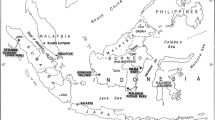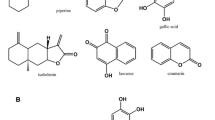Abstract
Earth from a termite mound in the Mahale Mountains National Park, Tanzania, eaten by chimpanzees, was analyzed to determine the possible stimulus, or stimuli, for geophagy. The termite mound sample contains relatively high aluminum (10.0%), iron (3.0%), and sodium (0.5%). This correlates well with the mineralogy of the clay (<2 µm) fraction, which is high in metahalloysite, a 1:1 (Si:Al=1:1) clay mineral similar in chemical composition to the clay mineral kaolinite, and smectite (montmorillonite), which is a 2:1 expandable clay mineral. The combination of metahalloysite and smectite produces a substance much like the pharmaceutical Kaopectate™ widely used by humans as an anti-diarrheal agent. These analyses and preliminary observations linking geophagy with instances of severe diarrhea, and other signs of gastrointestinal upset in the Mahale chimpanzees, suggest that one function for the ingestion of this substance by chimpanzees may be to help provide temporary relief from gastrointestinal ailments. Further detailed investigations into the relationship between health and geophagy should provide important insights into the diverse roles of this behavior as a form of self-medication.
Similar content being viewed by others
References
Brindley, G. W.;Brown, G. 1980.Crystal Structures of Clay Minerals and Their X-ray Identification. Mineralogical Society, London.
Collins, D. A.;McGrew, W. C. 1988. Habitats of three groups of chimpanzees (Pan troglodytes) in western Tanzania compared.J. Human Evol., 17: 553–574.
Davies, A. G.;Baillie, I. C. 1988. Soil-eating by red leaf monkeys (Presbytis rubicunda) in Sabah, Northern Borneo.Biotropica, 20(3): 252–258.
Day, P. E. 1965. Particle fractionation and particle size analysis. In:Methods of Soil Analysis,Black,C. A. (ed.), Amer. Soc. Agronomy, Madison, Wisconsin, pp. 545–567.
Fossey, D. 1974. Observations on the home range of one group of mountain gorillas (Gorilla gorilla beringei).Anim. Behav., 22: 568–581.
Fossey, D. 1983.Gorillas in the Mist. Houghton Mifflin, Boston, Massachusetts.
Fossey, D.;Harcourt, A. H. 1977. Feeding ecology of free-ranging mountain gorilla (Gorilla gorilla beringei). In:Primate Ecology: Studies of Feeding and Ranging Behavior in Lemurs, Monkeys and Apes,Clutton-Brock,T. H. (ed.), Academic Press, New York, pp. 417–447.
Hancock, R. G. V. 1978. Some aspects of the analysis of ancient artifacts by neutron activation.J. Int. Inst. Conservation-Canadian Grp., 3: 21–27.
Hancock, R. G. V. 1984. On the source of clay used for Cologne Roman pottery.Archaeometry, 26: 210–217.
Hladik, C. M. 1977. A comparative study of the feeding strategies of two sympatric species of leaf monkeys:Presbytis senex andPresbytis entellus. In:Primate Ecology: Studies of Feeding and Ranging Behaviour in Lemurs, Monkeys and Apes,Clutton-Brock,T. H. (ed.), Academic Press, New York, pp. 324–353.
Hladik, C. M.;Gueguen, L. 1974. Géophagie et nutrition minérale chez les primates sauvages.CR Acad. Sc. Paris Série D., 279: 1393–1396.
Huffman, M. A. 1994. The C.H.I.M.P. Group: a multidisciplinary investigation into the use of medicinal plants by chimpanzees.Pan Afr. News, 1(1): 3–5.
Huffman, M. A.;Gotoh, S.;Izutsu, D.;Koshimizu, K.;Kalunde, M. S. 1993. Further observations on the use of the medicinal plant,Vernonia amygdalina (Del) by a wild chimpanzee, its possible affect on parasite load, and its phytochemistry.Afr. Stud. Monogr., 14(4): 227–240.
Huffman, M. A.;Page, J. E.;Sukhdeo, M. V. K.;Gotoh, S.;Kalunde, M. S.;Chandrasiri;Towers, G. H. N. 1995. Leaf-swallowing by chimpanzees, a behavioral adaptation for the control of parasite infection.Mahale Mountains Research Project, Ecological Report, No.95, Kyoto Univ., Kyoto.
Huffman, M. A.;Seifu, M. 1989. Observations in the illness and consumption of a medicinal plantVernonia amygdalina by a wild chimpanzee in the Mahale Mountains, Tanzania.Primates, 30: 51–63.
Inoue, M. 1987. Soil-eating of Japanese Macaques (Macaca fuscata) at Arashiyama, Kyoto.Prim. Res., 3(2): 103–111. (in Japanese)
Johns, T. 1990.With Bitter Herbs They Shall Eat It: Chemical Ecology and the Origins of Human Diet and Medicine. The Univ. of Arizona Press, Tucson.
Johns, T.;Duquette, M. 1991. Detoxification and mineral supplementation as functions of geophagy.Amer. J. Clin. Nutr., 53: 448–456.
Mahaney, W. C. 1987. Notes on the behaviour of the African buffalo (Syncerus caffer caffer) on Mount Kenya.Afr. J. Ecol., 25: 199–202.
Mahaney, W. C. 1990.Ice on the Equator. William Caxton Press, Wisconsin.
Mahaney, W. C. 1991. Distributions of halloysite — metahalloysite and gibbsite in tropical mountain paleosols: relationship to quaternary paleoclimate.Palaeogeography, Palaeoclimatology, Palaeoecology, 88: 219–230.
Mahaney, W. C. 1993. Scanning electron microscopy of earth mined and eaten by mountain gorillas in the Virunga Mountains, Rwanda.Primates, 34: 311–319.
Mahaney, W. C.;Hancock, R. G. V. 1990. Geochemistry of African buffalo (Syncerus caffer caffer) mining sites and dung on Mount Kenya, East Africa.Mammalia, 54: 25–32.
Mahaney, W. C.;Hancock, R. G. V.;Aufreiter, S. 1995a. Mountain gorilla geophagy: a possible strategy for dealing with intestinal problems.Int. J. Primatol., 16(3): 475–487.
Mahaney, W. C.;Hancock, R. G. V.;Inoue, M. 1993. Geochemistry and clay mineralogy of soils eaten by Japanese Macaques.Primates, 34: 85–91.
Mahaney, W. C.;Stambolic, A.;Knezevich, M.;Hancock, R. G. V.;Aufreiter, S.;Sanmugadas, K.;Kessler, M.;Grynpas, M. 1995b. Geophagy amongst Rhesus macaques on Cayo Santiago, Puerto Rico.Primates, 36: 323–333.
Mananey, W. C.;Watts, D. P.;Hancock, R. G. V. 1990. Geophagia by mountain gorillas (Gorilla gorilla beringei) in the Virunga Mountains, Rwanda.Primates, 31: 113–120.
McConnell, R. B. 1950. Outline of the geology of Ufipa and Ubende.Bull. Geol. Surv. Tanganyika, 19.
Nishida, T. (ed.) 1990. A quarter century of research in the Mahale Mountains: an overview. In:The Chimpanzees of the Mahale Mountains: Sexual and Life History Strategies. The Univ. of Tokyo Press, Tokyo, pp. 3–35.
Nishida, T.;Nakamura, M. 1993. Chimpanzee tool use to clear a blocked nasal passage.Folia Primatol., 61: 218–220.
Nishida, T.;Takasaki, H.;Takahata, Y. 1991. Demography and reproductive profiles. In:The Chimpanzees of the Mahale Mountains: Sexual and Life History Strategies,Nishida,T. (ed.), The Univ. of Tokyo Press, Tokyo, pp. 63–97.
Nishida, T.;Uehara, S. 1983. Natural diet of chimpanzees (Pan troglodytes schweinfurthii): long term record from the Mahale Mountains, Tanzania.Afr. Stud. Monogr., 3: 109–130.
Oates, J. F. 1978. Water-plant and soil consumption by guereza monkeys (Colobus guereza): a relationship with minerals and toxins in the diet?Biotropica, 10: 241–253.
Ohigashi, H.;Huffman, M. A.;Izutsu, D.;Koshimizu, K.;Kawanaka, K.;Sugiyama, Y.;Kirby, G. C.;Warhurst, D. C.;Allen, D.;Wright, C. W.;Philipson, J. D.;Timmon-David, P.;Delnas, F.;Elias, R.;Balansard, G. C. 1994. Toward the chemical ecology of medicinal plant-use in chimpanzees: the case ofVernonia amygdalina (Del). A plant used by wild chimpanzees possibly for parasite-related diseases.J. Chem. Ecol., 20(3): 541–553.
Oyama, M.; Takehara, H. 1970.Standard Soil Color Charts. Japan Res. Council for Agriculture.
Pomeroy, D. E. 1983. Some effects of mound building termites on soils of a semiard area of Kenya.J. Soil Sci., 34: 555–570.
Robbins, C. T. 1983.Wildlife Feeding and Nutrition. Academic Press, New York.
Said, S. A.;Shibel, A. M.;Abdullah, M. E. 1980. Influence of various agents on absorption capacity of kaolin forPseudomonas aeruginosa toxin.J. Pharmaceutic. Sci., 69: 1238–1239.
Stark, N. M.;Jordan, C. F. 1978. Nutrient retention by the root mat of an Amazonian rain forest.Ecology, 59: 434–437.
Tuttle, R. H. 1986.Apes of the World: Their Social Behaviour, Communication, Mentality and Ecology. Noyes Publications, New Jersey.
Uehara, S. 1982. Seasonal changes in the techniques employed by wild chimpanzees in the Mahale Mountains, Tanzania, to feed on termites (Psedacant hotermes spiniger).Folia Primatol., 37: 44–76.
Vermeer, D. E.;Ferrel, R. E. 1985. Nigerian geophagical clay: a traditional antidiarrheal pharmaceutical.Science, 227: 634–636.
Vortisch, W.;Mahaney, W. C.;Fecher, K. 1987. Lithology and weathering in a paleosol sequence on Mount Kenya.Geol. Paleontol., 21: 245–255.
Whittig, L. D. 1965. X-ray diffraction techniques for mineral identification and mineralogical composition. In:Methods of Soil Analysis,Black,C. A. (ed.), Amer. Soc. Agronomy, Madison, Wisconsin, pp. 671–696.
Wrangham, R. W. in press. Leaf-swallowing by chimpanzees, and its relation to a tapeworm infection.Amer. J. Primatol.
Author information
Authors and Affiliations
About this article
Cite this article
Mahaney, W.C., Hancock, R.G.V., Aufreiter, S. et al. Geochemistry and clay mineralogy of termite mound soil and the role of geophagy in chimpanzees of the Mahale Mountains, Tanzania. Primates 37, 121–134 (1996). https://doi.org/10.1007/BF02381400
Received:
Accepted:
Issue Date:
DOI: https://doi.org/10.1007/BF02381400




